How To Build A Practical Martial Arts Gym Intranet With Omnia
Stop Drowning In Paperwork And Emails
Running a martial arts gym means juggling class schedules, belt promotion requirements, incident reports, member questions, and staff coordination. Most gym owners find themselves buried under scattered WhatsApp threads, stacks of paper waivers, and email chains that never seem to end. This administrative chaos pulls you away from what matters most: teaching, coaching, and building a thriving community on your mats.
The key to reclaiming your time and reducing operational stress lies in a simple, mobile-first intranet. This is not another complex software platform that requires a dedicated IT team or months of training. Instead, think of it as your gym’s digital headquarters—a single, accessible hub where members and staff can find schedules, policies, curriculum guides, and safety information instantly. This guide walks you through building a practical, focused intranet that will emerge as a staple in your gym’s daily operations, using straightforward tools and a realistic rollout timeline that fits your schedule.

What To Include In Your Digital Dojo Hub
The most common mistake gym owners make when building an intranet is trying to digitize everything at once. You are better off starting with the two or three features that solve eighty percent of your daily communication headaches. Identify what information your members and instructors request most frequently: class times, belt requirements, or onboarding documents. Build those pages first, make them mobile-friendly, and ensure they load quickly on any device.
Your digital hub should focus on high-value content that reduces repetitive questions and improves the member experience from day one. A well-designed intranet gives new students immediate access to what they need to succeed, while providing seasoned practitioners with curriculum details and event updates without requiring them to hunt through old emails or text messages.
Start with these core features that deliver immediate value:
- Class Schedules and Event Calendars: A live, mobile-accessible schedule that updates automatically eliminates confusion about class times, instructor changes, or holiday closures. Members can check the schedule before leaving home, reducing no-shows and improving attendance.
- Curriculum and Belt Promotion Guides: Clear documentation of techniques, requirements, and testing criteria for each belt level gives students a roadmap for progression. This transparency builds confidence and reduces the anxiety that comes with wondering what to practice next.
- Member Onboarding Portal: A dedicated section for new members with introductory videos, gym rules, equipment requirements, and answers to frequently asked questions shortens the learning curve and helps newcomers feel welcome from their first visit.
- Community Bulletin Board: A simple announcement feed for seminar invitations, competition results, member achievements, and gym news keeps everyone engaged and informed without cluttering their inbox.
Each of these features turns the tables on time-consuming administrative tasks. Instead of answering the same questions repeatedly or printing stacks of handouts, you direct members to a single source of truth they can access anytime. This frees your coaching staff to focus on instruction rather than logistics, and it demonstrates professionalism that sets your gym apart from competitors still relying on disorganized Facebook groups.
Your 30-Day Intranet Rollout Plan
A phased rollout prevents the overwhelm that sinks many digital projects before they launch. Breaking the process into four clear weeks ensures you build momentum, gather real-world feedback, and achieve genuine adoption rather than creating another platform that nobody uses. This structured approach also allows you to refine content and navigation based on actual user behavior before committing to a full gym-wide launch.
Week 1: Foundational Setup. Create your core pages during this first week: the class schedule, a basic curriculum outline for your primary programs, and a simple homepage that clearly directs visitors to each section. Assign clear ownership for each content area—decide who updates the schedule, who maintains curriculum documents, and who approves announcements. Establishing these roles early prevents confusion and ensures someone takes responsibility for keeping information current. Test navigation on multiple devices to confirm everything works smoothly on phones, tablets, and computers.
Week 2: Staff and Instructor Testing. Onboard your teaching team and administrative staff during week two. Walk them through the intranet, explain how to update their respective sections, and ask them to use it for their own coordination needs. Instructors can post technique videos or training notes, while front desk staff can practice updating the schedule and posting announcements. Gather their feedback: what feels confusing, what takes too many clicks, and what content is missing? Their daily experience will reveal usability issues you might not notice yourself.
Week 3: Member Pilot Program. Invite a small group of ten to fifteen dedicated members—those who regularly attend, ask thoughtful questions, and engage with the community—to test the platform. Send them clear instructions on how to access the intranet, what features to explore, and what kind of feedback you need. Ask specific questions: Can you find the belt requirements easily? Is the schedule readable on your phone? Would you use this to check gym news? Pilot members provide invaluable real-world perspective and often identify navigation problems that seem obvious once pointed out.
Week 4: Full Gym Launch. Announce the intranet to your entire membership through every channel available: email, social media, in-person announcements before and after classes, and printed flyers at the front desk. Provide simple, step-by-step instructions for accessing the platform, and highlight the specific benefits members will experience—less confusion about schedules, faster answers to questions, and a single place for all gym information. While many platforms exist, choosing a focused solution like the Omnia intranet platform is designed to simplify this process, providing the tools you need without unnecessary complexity. Promote the hub consistently for the first two weeks post-launch, reinforcing its value until checking it becomes a habit for your community.
Make Your Intranet A Safety-First Resource
Beyond convenience and efficiency, your intranet serves as a critical tool for health, safety, and emergency preparedness. Centralizing safety information demonstrates your commitment to member well-being and reduces liability by ensuring everyone has access to important protocols and procedures. A dedicated safety section gives members and staff confidence that you take their health seriously and have clear plans for handling incidents.
Create a prominently placed Safety section that is easy to find from your homepage. This area should contain essential resources that support a clean, safe training environment and prepare your team to respond effectively when incidents occur. You are better off posting clear, visible links to your cleaning procedures, following expert guidelines from sources like the CDC on how to clean and disinfect your facility effectively, especially for high-touch surfaces like mats, equipment, and door handles.
Include these critical safety resources in your intranet:
- Cleaning and Disinfection Protocols: Document your mat cleaning schedule, equipment sanitization procedures, and facility hygiene standards. Include product names, proper dilution ratios, and contact times required for effective disinfection. This transparency reassures members that you maintain a safe training space.
- Incident Reporting Forms: A simple, fillable form for reporting injuries, equipment damage, or safety concerns makes it easy for staff and members to document issues immediately. Timely reporting protects everyone and creates a paper trail that supports injury prevention efforts.
- Emergency Contact Information: List local emergency services, poison control, your gym’s first aid kit locations, and designated staff members trained in CPR and first aid. Make this information accessible offline by encouraging members to bookmark or screenshot the page.
- Procedures for Unexpected Closures: Outline your communication plan for weather emergencies, facility issues, or public health situations. Members need to know where to check for closure announcements and how quickly they can expect updates.
This safety-first approach builds trust with members and their families. Parents feel more comfortable enrolling children in programs when they can review safety protocols anytime. Adult members appreciate knowing you have thought through emergency scenarios and prepared clear procedures. This level of organization elevates your gym’s reputation and distinguishes you as a professional operation that prioritizes member welfare above all else.
Manage Access Privacy And Tech Glitches
Not all information should be visible to everyone. Setting appropriate access controls protects member privacy, secures sensitive data, and ensures that different audiences see only the content relevant to them. Public pages might include your class schedule and introductory information, while member-only sections contain belt requirements, training videos, and community announcements. Staff-only areas should house administrative documents, incident reports, and financial information that requires confidentiality.
Reference guidance from organizations like Nielsen Norman Group’s research on intranet usability to structure your information architecture around tasks rather than departments, making it easier for users to find what they need quickly. Protecting member information aligns with basic data privacy principles: collect only necessary information, secure it properly, and limit access to authorized users. This shows foresight and builds member confidence that you handle their personal data responsibly.
Anticipate common technical issues before they frustrate members. One frequent problem occurs when users encounter error messages stating that JavaScript must be enabled to view content. Rather than leaving members stuck at a technical barrier, create a simple fallback page with basic contact information, your gym’s phone number and email address, and a direct link to your class schedule hosted on a simple, accessible format that works without JavaScript. This also simplifies the member journey, ensuring everyone from seasoned practitioners to those getting ready to prepare for their first martial arts class has the correct information from day one.
Consider these practical access and troubleshooting solutions:
- Tiered Access Levels: Public content requires no login, member content requires a simple password or member number, and staff content requires elevated credentials. Keep the login process as simple as possible to avoid frustration.
- Mobile-First Testing: Most members will access your intranet from their phones while in the car or getting ready for class. Test every page on multiple mobile devices to ensure fast loading, readable text, and easy navigation with one hand.
- Clear Error Messages: When something goes wrong, display helpful error messages that explain the problem and offer a solution, not cryptic technical jargon. Include contact information so members can reach out if they remain stuck.
- Offline Alternatives: Keep essential information—schedule, emergency contacts, facility address—available through multiple channels. If the intranet goes down, members should have a backup way to access critical details.
These measures build trust and show that you have anticipated problems before they occur. Members appreciate a gym owner who makes technology work for them rather than creating barriers. By addressing access controls and technical issues proactively, you prevent frustration and ensure your intranet serves its core purpose: making life easier for everyone in your gym community.
Build Your Stronger Connected Community Today
A simple, well-planned intranet transforms gym operations from chaotic to streamlined, turning administrative burdens into opportunities for engagement. The core benefits speak for themselves: less time answering repetitive questions, better communication that reaches members reliably, enhanced safety through centralized protocols, and a more engaged community that feels informed and connected. Your members gain confidence knowing they can access schedules, curriculum, and important updates anytime, while your staff reclaims time previously lost to managing scattered information across multiple platforms.
Start by mapping out your two or three most critical features—the ones that will solve the majority of your communication challenges immediately. Create those pages first, test them thoroughly with a small group, and launch with confidence knowing you have built something practical and valuable. The key lies not in creating the most feature-rich platform, but in delivering reliable, accessible information that becomes an indispensable part of your gym’s daily rhythm. Take the first step this week, and watch your digital dojo hub strengthen the community you have worked so hard to build.

